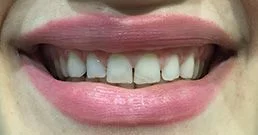Even the most perfect teeth may have minor defects in shape. Disturbing interdental areas, fractures, and minor caries. Replacements by dental bonding and cosmetic bonding provide an effective and cheap solution for these problems.
In this article you can read more about the following topics:

- A brief explanation of the method
- Use for cosmetic purposes
- Correction of faulty or unhealthy teeth
- Advantages and disadvantages of dental bonding
Dental bonding techniques and aesthetic corrections by cosmetic bonding have become prevalent techniques of dentistry, parallel to the proliferation of light-curing composites.

These are transparent, light, and gypsum –like materials that are easy to shape. After some preparation, they form a close bond with the natural material of teeth. They harden rapidly under ultraviolet or laser light. These materials and the dental bonding technique which fixes them have several advantages. Both patients and dentists enjoy the benefits when choosing this treatment.
A brief explanation of the method
The advantage of the treatment is that it requires only a minimal amount of intervention on the healthy tooth’s material i.e. the enamel. Consequently there is no need of anesthesia. Except when it is used for filling a deeply carious tooth, or the border of the fracture is too close to the inner layers of the tooth. The procedure is easy to understand:
- Step one: the dentist cleans the surface of the tooth, and then uses a slightly acidic material to roughen it. Further materials help the composite to bond and adhere to the tooth.
- Step two is placing the composite in the desired place, after which the dentist shapes the material using a brush or manual tools.
- Step three is using ultraviolet or laser light to light the composite, which sets within few minutes.
- Step four involves gently shaping the hardened replacement, and smoothing any unevenness.
Use for cosmetic purposes
Dental bonding techniques based on a composite are quite frequent in cosmetic treatments. This method serves for closing too large interdental areas, shaping teeth, and improving the appearance of stained teeth. It can also correct the broken, chipped edge of the teeth. Generally it is a good solution for minor corrections. It is important to have enough of the original dental material to which the composite replacement can bond. Another reason to emphasize the importance of minor corrections is that the force of dental bonding is not as great as the strength of layers or crowns. For this reason, it is used on the surface of teeth which only play a minor role in chewing. The patient can eat or drink anything following this treatment of the tooth. However, the patient must not bite hard materials or put too much tension on the composite replacement.
 We should also consider how dental bonding restores the mental balance of patients. Surveys have revealed that people with high aesthetic consciousness are upset because of their imperfect smile or faulty teeth. That can mean a tooth with an irregular shape, or a too large interdental area between the incisors, which shows while smiling or talking. The patients can regain their peace of mind when a cosmetic dentist solves such problems. The dental bonding technique that we present here is an excellent tool for this purpose.
We should also consider how dental bonding restores the mental balance of patients. Surveys have revealed that people with high aesthetic consciousness are upset because of their imperfect smile or faulty teeth. That can mean a tooth with an irregular shape, or a too large interdental area between the incisors, which shows while smiling or talking. The patients can regain their peace of mind when a cosmetic dentist solves such problems. The dental bonding technique that we present here is an excellent tool for this purpose.
Note that this procedure cannot always be the solution. It is the duty of the dentist to decide whether dental bonding or some kind of other treatment is actually the best solution for the patient. Layers or crowns could be an alternative, but you need a dental laboratory to make them. It takes more time to produce them, and the patient needs to see a dentist on more occasions.
Correction of faulty or unhealthy teeth
Dental bonding based on a composite is a good solution for curing minor cavities as well. It could be an alternative to dental amalgams that are rarely used nowadays. In certain cases it could replace them.
Advantages and disadvantages of dental bonding
 Like any other procedure, dental bonding has its own advantages and minor disadvantages. The advantage is that it is relatively inexpensive, it is easy to carry out and only takes little time. The dentist may perform the whole procedure, no assistance of a dental technician is necessary in the process. It is an effective tool for the corrections of minor faults. It also spares the material of teeth. There is no need for dental anesthesia.
Like any other procedure, dental bonding has its own advantages and minor disadvantages. The advantage is that it is relatively inexpensive, it is easy to carry out and only takes little time. The dentist may perform the whole procedure, no assistance of a dental technician is necessary in the process. It is an effective tool for the corrections of minor faults. It also spares the material of teeth. There is no need for dental anesthesia.
If implemented correctly, its disadvantages could hardly be recognised, but they do exist. The composite material cannot withstand staining and discolouration as effectively as the materials of layers and crowns. Its hardness and persistence is not as great as that of crowns, layers or inlays. For this reason, careful consideration, estimation and good professional knowledge are necessary for its successful implementation.


